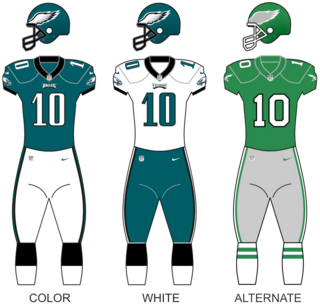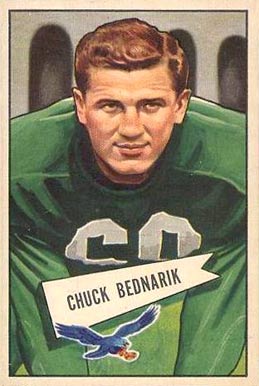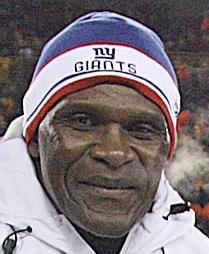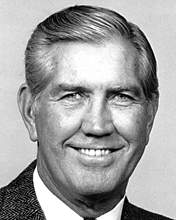
The Philadelphia Eagles are a professional American football team based in Philadelphia. The Eagles compete in the National Football League (NFL) as a member club of the league's National Football Conference (NFC) East division. The team plays its home games at Lincoln Financial Field in the South Philadelphia Sports Complex.

Francis Newton Gifford was an American football player, actor, and television sports commentator. After a 12-year playing career as a halfback and flanker for the New York Giants of the National Football League (NFL), he was a play-by-play announcer and commentator for 27 years on ABC's Monday Night Football.

Charles Philip Bednarik, nicknamed "Concrete Charlie", was an American football linebacker and center who played in the National Football League (NFL). He played college football for the Penn Quakers, and was selected in the first overall pick in the 1949 NFL draft by the Philadelphia Eagles, where he played his entire 14-year NFL career from 1949 through 1962. Bednarik is ranked one of the hardest hitting tacklers in NFL history, and was one of the league's last two-way players, so he was also known as "60 Minute Man".
Wesley Carl Hopkins was an American professional football player who played as a safety for the Philadelphia Eagles during his entire 11-year National Football League career from 1983 through 1993. A walk-on for the Southern Methodist football team, he was first noticed by coaches and teammates during a team practice after he made a ferocious tackle on his college teammate and future Pro Football Hall of Fame running back Eric Dickerson. Hopkins was named to the All-Conference selection in each of his last two seasons at SMU.

Thomas Franklin McDonald was an American football flanker who played in the National Football League (NFL) for the Philadelphia Eagles, the Dallas Cowboys, the Los Angeles Rams, the Atlanta Falcons, and the Cleveland Browns. He played college football as a halfback for the Oklahoma Sooners. He is a member of the Pro Football Hall of Fame and College Football Hall of Fame.

Ollie Genoa Matson II was an American Olympic medal winning sprinter and professional football player. He played as a halfback and return specialist in the National Football League (NFL) from 1952 to 1966 for the Chicago Cardinals and the Los Angeles Rams. He played college football for the San Francisco Dons and was selected by the Cardinals in the first round of the 1952 NFL draft.

Harry Donald Carson is an American former professional football player who spent his entire career as a linebacker for the New York Giants of the National Football League (NFL). Carson was inducted into the College Football Hall of Fame in 2002 and the Pro Football Hall of Fame in 2006.

Howard Albert "Hopalong" Cassady was an American football halfback and split end who played in the National Football League (NFL). He played college football for the Ohio State Buckeyes, where he won the Heisman Trophy in 1955. Cassady played in the NFL for eight seasons, seven of them for the Detroit Lions, with whom he won the 1957 NFL Championship Game. He was inducted into the College Football Hall of Fame in 1979.

Leonard Allen Marshall Jr. is an American former professional football player who was a defensive lineman for twelve seasons in the National Football League (NFL). Selected 37th overall in the 1983 NFL Draft, he spent the first ten seasons of his career with the New York Giants where he accumulated 79.5 sacks, ranking him third in team history. He was twice selected to the Pro Bowl and twice named NFL Defensive Lineman of the Year following the 1985 and 1986 seasons. He won two championships with the Giants, recording three sacks in the two Super Bowl games which he played in. Marshall is most famously known for his 1991 hit on Joe Montana that knocked him out of the NFC championship game, after which Montana would not play another regular season game for almost two years. After his time with the Giants, Marshall went on to play a season each for the New York Jets and Washington Redskins before retiring from football at the age of 33. Marshall played college football at Louisiana State University.
The 1949 NFL draft was held on December 21, 1948, at The Bellevue-Stratford Hotel in Philadelphia. The draft was preceded by a secret draft meeting held November 15, 1948, at the Hotel Schenley in Pittsburgh.
Irvin Acie Cross was an American professional football player and sportscaster. He played cornerback in the National Football League (NFL) and was a two-time Pro Bowl selection with the Philadelphia Eagles. Working with CBS, Cross was the first African-American sports analyst on national television. He was an initial co-host of The NFL Today, which became the pregame show standard for all television networks.

Andre Maurice Waters was an American professional football player who was a safety for the Philadelphia Eagles and Arizona Cardinals of the National Football League (NFL) from 1984 to 1995. Waters was regarded as one of the NFL's most aggressive players, serving as an integral part of one of the league's top defenses. On November 20, 2006, Waters died by suicide and was subsequently diagnosed with chronic traumatic encephalopathy (CTE). He is one of at least 345 NFL players to be diagnosed after death with CTE, which is caused by repeated hits to the head.
John Leonard Wilbur was a professional American football offensive lineman in the National Football League (NFL) for the Dallas Cowboys, Los Angeles Rams and Washington Redskins. He also was a member of The Hawaiians in the World Football League (WFL). He played college football at Stanford University.

Lewis Glen Carpenter was an American football player and coach. He played college football for the University of Arkansas and professionally for ten seasons in the National Football League (NFL) as a halfback and fullback with the Detroit Lions, Cleveland Browns, and Green Bay Packers. He played on three NFL Championship teams, with Detroit in 1953 and with Green Bay in 1961 and 1962. After his playing career ended, Carpenter spent 31 years as an assistant coach in the NFL with the Minnesota Vikings (1964–1966), Atlanta Falcons (1967–1968), Washington Redskins (1969), St. Louis Cardinals (1970–1972), Houston Oilers (1970–1974), Green Bay Packers (1975–1985), Detroit Lions (1987–1988), and Philadelphia Eagles (1990–1994). Carpenter also coached the Frankfurt Galaxy of the World League of American Football in 1996 and at Southwest Texas State University. He concluded his 47 years of playing and coaching football at the end of the 1996 season. Scientific tests on his brain diagnosed post-mortem that he had an advanced case of chronic traumatic encephalopathy (CTE).
George Michael Savitsky was an American football offensive tackle in the National Football League (NFL) for the Philadelphia Eagles.
The 1960 New York Giants season was the franchise's 36th season in the National Football League. The Mara family was opposed to the AFL adding a team in New York, but received an indemnity fee of ten million dollars.
The 1960 Philadelphia Eagles season was the franchise's 28th season in the National Football League, and finished with the Eagles' win over the Green Bay Packers in the NFL championship game to get their third league title. The victory over the Packers was also the first and only playoff defeat of the Packers' Vince Lombardi's coaching career. The 1960 season was the Eagles' first postseason appearance since their last NFL championship season of 1949. It was their only postseason appearance in the 28 seasons from 1950 to 1977, and their last NFL title until their victory in Super Bowl LII, 57 years later.
The 1953 Philadelphia Eagles season was their 21st in the league. The team improved on their previous output of 7–5, going 7–4–1. The team failed to qualify for the playoffs for the fourth consecutive season.
The 1952 Philadelphia Eagles season was their 20th in the league. The team improved on their previous output of 4–8, winning seven games. The team failed to qualify for the playoffs for the third consecutive season.
Ronald James Gibbs was an American football player, coach, and referee.











